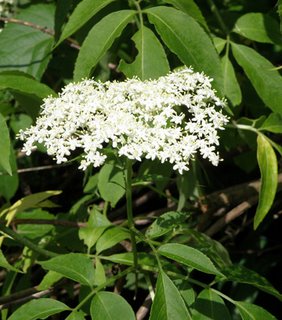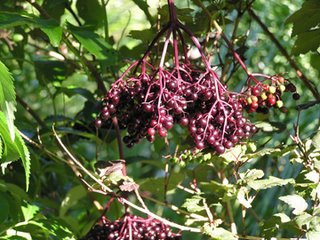St-Germain
Friday, June 19, 2009
Lately, there has been a lot of buzz about a newly-discovered quaff -- or rather, a new liqueuer that suggests a long-lost obscurity that has found a new luster. St-Germain is a cordial flavored with elderberry blossoms that have been harvested, we are told, by Alpine gypsies on bicycles. Who knows if any of that is true -- but it sounds great, and the mysterious infusion comes in an elegant eight-sided bottle of cut glass that screams "Belle Epoque" (with an acute accent over the "E"), or -- in plain English -- "expensive!" Its price varies, usually around thirty dollars a bottle (which is considerably more than another favorite cocktail ingredient, Lillet).
I searched for some, but none of the local liquor stores carry it yet, so I'm including, below, a recipe I'm trying to make some for myself. We'll see how it comes out in about a month.
While the company's website presents an elegantly old-fashioned image, complete with tales of the procurement of the all-too brief blossoms, St-Germain is not based on some secret recipe discovered in an ancient monastery. Its exact recipe may be a secret, but it was invented quite recently (in response to a fad among bartenders: making cocktails with elderblossom syrups).
The syrup has been around for a long time (in German, it's known as Holunderblutensirup -- with an umlaut over the "u"). It often added to champagne, hot tea, lemonade and even poured over pancakes. The flowers themselves, borne on flat umbrella-like clusters called "umbels," can be dipped in batter and deep-fried. An Italian version, called called Fritelle di Fiori di Sambuca, uses a little grappa in the batter. Most of these fritter-like desserts are served with a sprinkling of powdered sugar.

One more thing: don't pick all of the available elderberry blossoms -- or there won't be any berries, later on! In the summer, you can make wine (elderberries have been known as "the English grape"), jelly, and syrup from the ripe berries. You can read a lot more about elderberries here (it's an excerpt from my book, The Herbalist in the Kitchen).
Elderflower Cordial
This recipe is a home-made version of the trendy St. Germain liqueur.
Make sure to read the notes at the end of the recipe.
Make sure to read the notes at the end of the recipe.
Ingredients
4-5 elderberry blossom flower heads per cup of vodka
1/2 lemon, sliced thinly, per quart of vodka
approximately 1 cup heavy syrup per 2 cups of vodka (see note 4, below)
Method
1. Snip the flowers off the stalks, leaving as little stem as possible, into a suitably-sized Mason jar. Add lemon slices.
2. Cover with the vodka and seal.
3. Place in a cool, dark place to rest for a month.
4. Strain the flowers and debris through cheesecloth and return the alcohol to the jar (you can filter through paper coffee filter if small bits of flowers remain). Rinse jar.
5. Add simple syrup to taste, and return to jar (the ratio given in the ingredient list will yield a liqueur of about 40 proof). After it rests a while, you may notice some fine sediment at the bottom -- at that point, when it's perfectly clear, decant carefully into bottles.
Notes
1. Flowers should be gathered before noon, when most of their nectar is still in the blossoms. Avoid picking blossoms that grow next to busy roads (no matter how convenient they may seem), as they are likely to carry all sorts of automotive pollutants.
2. Trim the flowers from the stems over a large bowl. Insects love these flowers for the same reason we do: the fragrant nectar. The insects, being heavier than the blossoms, will tend to collect at the bottom, making their removal easier. Don't worry that a few might wind in the jar; a month in strong alcohol is sure to kill any bacteria they might be carrying.
3. Heavy syrup is made by heating three parts sugar to two parts water, and stirring until completely dissolved. Add syrup gradually, tasting frequently.
4. WARNING: Parts of the plant (leaves, stems, and probably roots) contain cyanide-like toxins. Be careful to exclude any of those parts when using elderberry flowers or fruit in any recipe.


5 Comments:
Very nice, Gary. I don't have any blossoms here, so you'll have to report back on the results. We used to pick elderberries in Washington state when was growing up. My parents made jam with them, if I recall correctly.
I'm thinking that -- while the flowers are still around -- I should make some Elderblow syrup too. One can never have too many different sweet things stashed away in the pantry...
That reminds me i have to make the yearly batchof umeshu/plums preserved with sugar and plent of Japanese sake and shochu!
Cheers,
Robert-Gilles
Robert-Gilles,
Are those the same as umeboshi -- the dried pickled plums colored with shiso?
I strained and sweetened the cordial today (and adjusted the recipe slightly). I was a little disappointed in the aroma -- it's not nearly as fragrant as the elderflower syrup I made.
Why the difference?
I think it's because of the means of extraction: the cordial simply soaked the flowers in alcohol for a month, while the syrup was poured HOT over the flowers and left to sit for five days. Next year I'll try to adjust the method. I might also delete or reduce the amount of lemon.
Too late to try this year -- the flowers are gone now!
Post a Comment